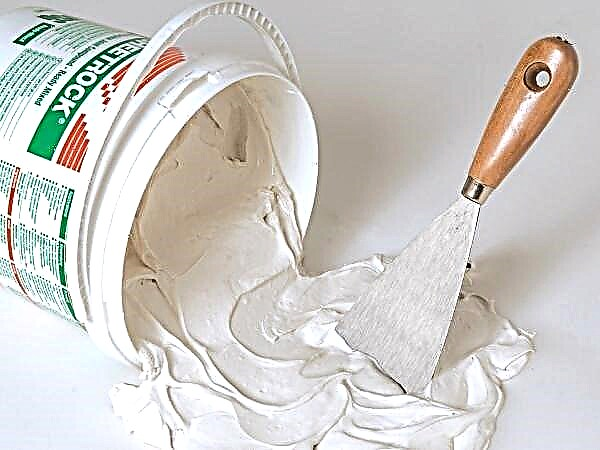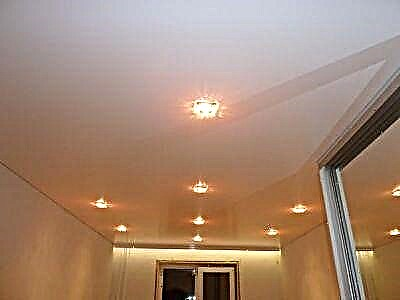Creating original room decor, sometimes the main highlight is stretch ceilings. They allow you to achieve a feeling of luxury, create an original and unique atmosphere. However, there are times when the surface of the ceiling is damaged. Various factors can contribute to this, including non-compliance with operating rules.
If damage has appeared on the surface of the stretch ceiling, the first thing that comes to mind is the replacement of the entire structure. Despite this, you need to look at the situation again. Thanks to modern technology, you can easily and easily repair a breakdown. You can use ordinary glue for this.
Common Causes of Cuts
The causes of cuts on the stretch ceiling can be many factors. Even childish pranks can lead to holes in the ceiling.
Therefore, in order to avoid such an unpleasant embarrassment, it is worth knowing the most common reasons:
- cornices - very often contribute to the formation of tears in the surface of the stretch ceiling. Typically, this occurs with a sloppy installation. To avoid this, place a soft cloth pad between the sharp ends of the cornice and the ceiling that would reliably protect the material from damage,
- Please note that children's toys with sharp ends can also damage the surface of the ceiling,
- champagne cork - do not forget that the stretch ceiling is very fragile and it will tear if a wooden cork hits
- during installation work it is not necessary to pull the film very much, since it can go apart along the seam,
- Again, when installing a stretch ceiling, you need to be sure that all profiles are securely fixed to the structure, otherwise in the future they can move away from the wall and form a hole,
- High power luminaire can easily melt the film. This is not only about those models that are built into the ceiling, but also about pendant lamps that were not installed correctly. Ideally, the distance between the ceiling and the chandelier should be at least 10 cm.
When is repair not possible?
There are times when repairs fail. This applies to cuts that have formed at the seam. In this case, you need to reinstall a new canvas, other methods are simply impractical.
If suddenly a defect is formed from the built-in lamp, then use a special ring that will mask the surface and prevent damage in the future. If the cut formed near the wall, then it is simply cleaned. To do this, it is enough to remove the baguette, cut off the cut fabric and again fill the material under the baguette. You can also install a ventilation grill if it is appropriate at the point of rupture.
If the harpoon ruptured, then you yourself cannot do it. Feel free to call a specialist who, thanks to his knowledge, will be able to quickly and accurately repair damage. In general, use your imagination to the maximum, in this case it will work for you.
Causes of damage to the stretch ceiling
Defects in the material arise for various reasons. Most often, the stretch ceiling breaks in the following situations:
- negligence in the process of construction and installation work, due to which a sharp spatula or other tool leaves a cut,
- dismantling and installation of window structures, furniture movement and other work in which there is a careless touch on the material,
- installation of an initially defective cloth of poor quality, improperly executed cutting of the ceiling,
- the formation of bulges and subsequent cracking during flooding as a result of plumbing leaks in the apartment from above,
- prolonged use of the material with unstable indicators of temperature and humidity in the room.

DIY repair methods for a puncture
It is not practical to eliminate large defects in the tensile structure, since it will be cheaper and less laborious to pull new material. In this case, small punctures and cuts can be masked if, immediately after the occurrence of the defect, it is possible to prevent creeping. Having noticed a hole on the canvas, you need to glue the damaged area with tape or tape and proceed to further work. You can independently eliminate the puncture with the help of a fabric or PVC cloth, and these methods perform differently.

What happens if you pierce the stretch ceiling
Holes and cuts appear due to bumps or other impacts with sharp objects. Inaccurate movements by tools during repairs often become the cause, for example, during the installation of a cornice or cabinet or unsuccessful attempts to remove furniture, ski poles, billiard cues and other things with sharp edges. With a blunt object, even upon impact, it is practically impossible to scratch or perforate the ceiling.
Cuts on the film are easier. The fabric is denser and more durable, but you can also damage it. A hole is formed at the puncture site. It looks messy, but nothing bad will happen. A cut is a more unpleasant damage, as it spreads over time under the action of tension forces. As a result, instead of minor damage that is easy to repair, a large hole forms.
In case of a cut, it is necessary to immediately seal the stretch ceiling with masking tape so that the canvas does not spread further. Ordinary adhesive tape is also suitable, traces after the completion of the repair can be removed with ammonia.
Other damages sometimes occur:
- the divergence of the seam between the individual canvases (the actions are the same as with the cut),
- insufficient fixation, which is why the baguette moves away from the wall (additional reinforcement of the frame in this place will be required).
In these cases, fixing the ceiling is more difficult, but restoration work will cost less than a complete replacement of the canvas.
Is it possible to close a hole on my own
If the ceiling was installed with your own hands, then gluing it without involving specialists will not be difficult, since there are already the necessary skills and tools. If there is no experience, then you can independently repair only small holes and cuts. Everyone can stick a patch or decorative sticker. More complicated repair methods, such as installing an additional lamp at the puncture site or re-painting the fabric should be entrusted to professionals. The same applies to serious damage such as a rupture of the film or the profile moving away from the wall.
Companies involved in the installation of suspended ceilings, always provide a guarantee. Certain types of repairs are free of charge. As a rule, this is the elimination of problems associated with defects of specialists. Cuts and punctures that appear due to the careless actions of the owners or other repairmen are cleaned for a fee.
It is important to remember that any interference with the ceiling structure (for example, installing new elements or partial dismantling) will void the warranty.
In cases where the installation was carried out by specialists, you must first find the contract and check whether the warranty period has expired. And if it is over, it is worth weighing the risks of self-repair, as inept actions can lead to more serious damage to the canvas. It is cheaper to patch a small hole than a large cut.
What glue is suitable for a stretch ceiling
To repair the stretch ceiling, a composition is required that reliably fixes the canvas and does not damage the PVC film or fabric. Professionals choose the “Cosmofen CA 12” cyanoacrylate. This is a one-component adhesive that is used for any plastics, rubber, leather and even metals. In the case of stretch ceilings "Cosmofen" is used for such works:
- harpoon connection
- repair of vinyl films and polyester fabrics,
- gluing a harpoon to a PVC cloth,
- installation of thermal rings, bypasses for pipes and ventilation grilles.
Advantages of Cosmofen glue:
- quickly sets because it has high adhesion,
- dries completely after 6 hours (at an air humidity of about 60% and a temperature of + 20ºC, in other conditions the time may differ),
- securely fixes glued surfaces,
- not harmful to health, as it is not toxic,
- resistant to frost, heat and sunlight (used both in the house and on the street),
- not susceptible to mold or corrosion.
Attention! It is not recommended to use ordinary super-glue and other similar means. An improper composition may not provide a reliable connection of materials and even damage the canvas.
Gluing patch
The method is suitable for small cuts or scratches. For this, a piece of cloth or film remaining after installation is useful. This repair method has two variations. The easiest way is to glue the patch directly on top of the puncture. To close a cut on a torn stretch ceiling, proceed as follows:
- Cut out from the canvas a piece of the desired size and shape (so that the hole overlaps with a margin).
- Smeared with Cosmofen glue.
- Apply to the ceiling and smooth.
In this case, the patch will be noticeable. If the type of fastening allows, it is better to partially remove the canvas and glue the patch on the inside, and then put the harpoon back into the baguette.
Sticker decoration
If the patch cannot be hidden, a good solution would be to turn it into an element of decor. The room will look unusual and interesting.
The method is suitable for:
- canvases that can not be re-mounted (with glazing or cam fastening),
- holes of medium size (5-10 cm).
Reusable stickers for interiors, which are sold in large stores of goods for home or construction, are suitable.The subjects are the most diverse: flowers, insects, animals, travel, landscapes, etc.
To close a hole in a stretch ceiling, you need:
- Carefully remove the self-adhesive appliqué from the white backing.
- Put from one edge to the ceiling near the cut.
- With careful movements, straighten the image, slowly gluing it to the surface.
Make sure that there are no air bubbles. If this happens, the patch is partially peeled off and smoothed again. You can pierce the tubercle with a needle, but very carefully so as not to touch the canvas.
Advice! To make the interior look more harmonious and complete, they place several images in different places.
If the cut is located near the chandelier, there is another option. You can install a decorative outlet. For a stretch ceiling choose a lightweight foam product.
Installation of the ventilation grill
As a rule, a diffuser is placed if a puncture or cut has occurred in a corner. The size of the element is selected so that it is more than a defect.
Repair of a stretch ceiling is as follows:
- A plastic ring is glued to the canvas (damage should be inside).
- If necessary, additionally cut the PVC film.
- Insert the grill.
This method is suitable for all materials and types of fastening. The diffuser will provide additional air circulation. In addition to the cut, problems such as sticking or sagging of the film are eliminated.
Spotlight Installation
The option is similar to the previous one, but more complicated in execution. Suitable only for ceilings with harpoon mounting system, as you have to partially remove the canvas. In addition, you will need electrician skills.
Installation is as follows:
- From the cut side, a part of the web is dismantled.
- A mortgage screw is screwed to the rough floor in the place where the lamp will be located.
- Lay wiring and connect to the network.
- Set the canvas back.
- Glue the thermal ring, cut out the film and remove the cable.
- Connect the lamp and insert into the hole.
Features! It is not necessary to be limited to one light bulb, you can arrange them in a group: a straight or curved line, in the form of a geometric figure, etc. Such a highlight helps to highlight a certain area.
Complete elimination of a cut near the wall
This method also applies only to film ceilings with harpoon joints. There is another limitation - the distance from the hole to the wall should be no more than 15 cm.
The ceiling is repaired as follows:
- The harpoon is partially pulled out of the baguette at the cut site.
- Cut off the damaged area.
- Re-stick the edge to the canvas in small steps of 2-3 cm.
- This section of the film is heated and fixed in the profile.
It's okay that the canvas will have to be shortened a little. Vinyl film stretches well, with accurate work after restoration, the surface will look like new.
What to do if the stretch ceiling breaks
This is pretty serious damage. Possible causes of a crack:
- the cut wasn’t taped right away and it sold a lot,
- inaccurately installed a lamp or ventilation grill, there is no tread ring that does not allow the film to tear,
- improper cutting resulted in too much tension, due to which the canvas cracked (this is possible only if poor-quality film is used or welding of welds is poorly performed).
In such cases, you need:
- Trim the edges if they are uneven.
- Glue a harpoon to both sides of the gap.
- On the ceiling at the junction, install a special dividing profile (should be on the same level with the rest of the frame).
- Insert the canvas into the baguette.
- Decorate the junction with masking tape to match the surface color.
Unfortunately, with significant damage, part of the ceiling will have to be changed. But it is cheaper than buying and installing a new canvas.
What to do if the stretch ceiling has moved away from the wall
The reason for this shortcoming is the insufficiently fastening of the frame:
- too rare step
- low-quality screws,
- loose walls (for example, partitions made of drywall or aerated concrete) without additional fixation.
As a result of the action of tension forces, a gap can form between the profile and the partition.
To fix this drawback, you will have to dismantle the canvas (around the entire perimeter or only in those places where it is not firmly held) and fix the baguette in addition. There are three methods that apply in different situations:
- If the wall is strong, and fastening is done too rarely (step more than 15 cm), it is enough to screw in additional screws.
- Several loose screws are screwed into the loose partitions (gypsum plasterboard, aerated concrete) at once, and they are placed with a "herringbone", that is, at an angle and in different directions.
- A more reliable way is to install the spacers. It is also chosen when it is difficult or impossible to drill additional holes (for example, when tiled).
Let us dwell on the latter option in more detail. You will need pieces of baguette, fasteners and tools.
Progress is as follows:
- Spacers are made, for this, the baguette is cut into pieces of the desired length.
- Apply one end to the profile, and the other to the ceiling, mark the location.
- Hole drills in a concrete slab.
- Using a dowel, fix the segment from above.
- The second piece of the profile additionally wedges the support, screwing it to the frame.
- After that, warm the film and install the ceiling in place.
What cases come under warranty
Repair is free when defects arise due to the fault of the manufacturer or installer. The main situations are as follows:
- There was a seam between the cuts of the PVC film.
- The stretch ceiling frame moves away from the wall.
- The film or fabric is poorly tucked into the baguette.
- The harpoon is not soldered well enough.
In the first case, the manufacturer gives a guarantee on the quality of adhesions and is obliged to install a new canvas for free. In other situations, warranty repairs are carried out.
Another possible cause of damage is crumbling pieces of plaster or other finishes. In this case, it is important who did the preliminary work. If the installation company of the ceiling, then the masters must eliminate the consequences for free. And with self-preparation, you will have to pay for repairs.
Note! Not all of these situations may be covered under warranty. It is necessary to carefully read the contract, since the conditions for different companies may vary.
Non-warranty cases include the following situations:
- inaccurately mounted a cabinet or cornice and punctured or cut the film,
- homeowners dismantled the ceiling and damaged the canvas,
- the neighbors made a flood and the film burst under the weight of water.
Inaccurate handling, the stretch ceiling is easily punctured and torn. It can also crack from excessive pressure. But often a complete replacement is not required, just make redecorating. Some jobs are even covered under warranty.
The cloth
If after installation of the stretch ceiling there is excess material left, it is suitable for masking the defect. If there is no patch, you can choose a piece of fabric that is suitable for the shade and texture. When the search for matter is unsuccessful, it is worth contacting the company that was engaged in the installation of the ceiling to find a fabric that is similar or similar in color. Then the damage is repaired according to the following instructions:
- Measure the dimensions of the cut and adjust the patch. It is recommended to leave a couple of additional centimeters on each edge of the defect.
- On the surface of the patch, on one side, a transparent layer of adhesive is applied.
- The material is applied to the damaged area of the tension coating and thoroughly smoothed.
- With a little effort, the patch is pressed against the canvas. Excessive pressure may cause glue to protrude and the treatment site will sag.
- When the glue dries and the patch holds firmly, if necessary, the surface of the canvas is partially painted for additional masking.
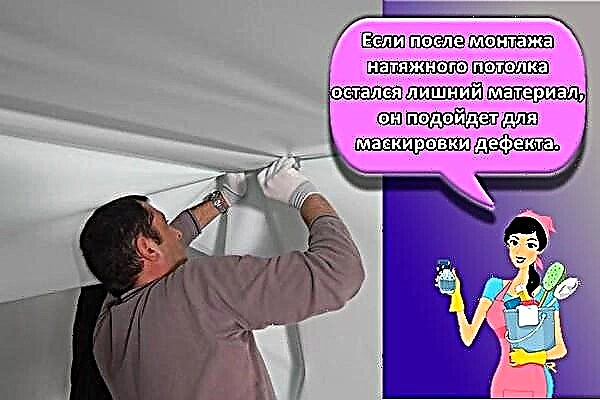
PVC cloth
Using a PVC cloth, it is possible to eliminate damage no longer than 2 cm. The process for masking defects is similar to the method that involves the use of a fabric patch, but has a number of features. Including:
- it is impossible to repaint the PVC film in a different color, so you need to prepare a patch from the material left after installation, or independently come up with an application in tone or contrast,
- if you cannot find a suitable patch, you can close the cut with a decorative element - a butterfly, a flower, an abstract geometric figure,
- the slots on the PVC material tend to grow quickly, so the tape from the damaged area is removed immediately before gluing a permanent patch.

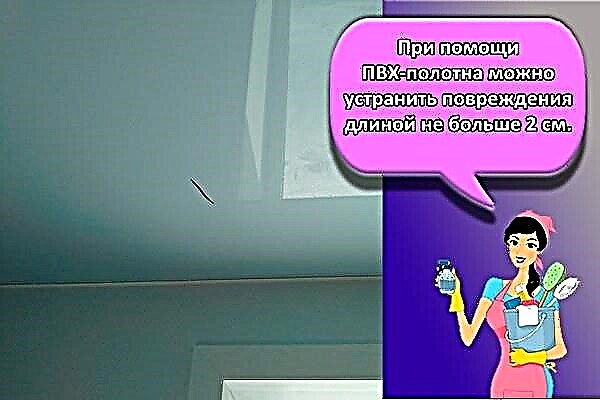
Glue selection
You can fix the patch on the damaged area of the stretch ceiling with different types of glue.
Regardless of the brand chosen, the adhesive solution must necessarily meet the basic requirements: be transparent so as not to leave spots on the ceiling, instantly harden and not destroy the surface of the tension coating.
Cosmofen
Glue "Cosmofen", according to many experts, is considered the best option for stretch linens. The solution is a universal tool and provides bonding of the material in a few seconds, leaving no residue. Complete drying occurs 15-16 hours after application to the material. It is not recommended to use Cosmofen only for gluing cuts on the ceiling with a porous surface, as this may affect the quality of gluing.
The cyanoacrylate solution is not susceptible to sudden changes in temperature and moisture, which allows it to be used in rooms with any conditions. The glue is supplied in a small package and is economically consumed - a few grams of the substance are enough to fix the patch. Cosmofen can be purchased at any hardware store or building materials department.
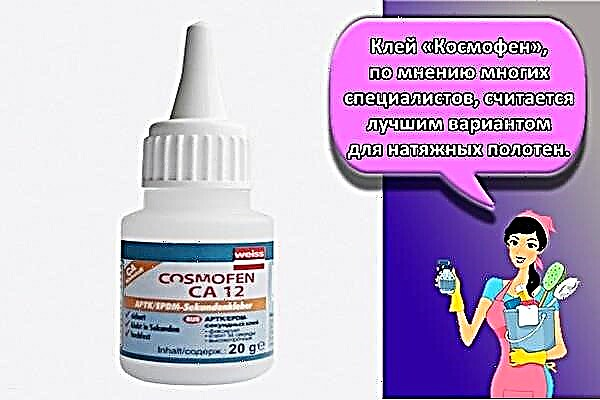
Somafix
The universal adhesive activator Somafix instantly forms an ultra-strong bond between patch and stretch fabric. The final setting time does not exceed 10 seconds. The solution contains ethyl cyanocrylate gel and an aerosol hardener. After application, Somafix glue does not spread, remains transparent and invisible. To ensure reliable adhesion, before using Somafix mortar, it is necessary to remove dust and dry the work surface.
"Contact"
The Contact one-component super-glue forms a strong seam and dries up almost immediately after application. The resulting compound is durable, resistant to organic solvents and temperature extremes.
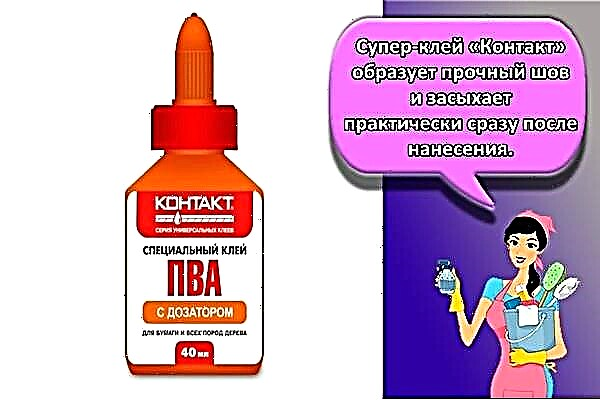
Loctite
Loctite Instant Adhesive is a one-component solution that cures at room temperature. Different types of adhesive sold under the Loctite brand have a viscosity index. The solution is used for strong bonding of a large number of materials, including stretch fabrics. The setting speed is a few seconds.
Cosmoplast
Cosmoplast Instant Cyanoacrylate Adhesive forms a strong bond with just a few drops. Practical plastic packaging ensures accurate patch coating for stretch coating. Among the advantages of the adhesive solution "Cosmoplast" include:
- hard glue line
- resistance to humid environment and temperature changes,
- lack of solvents in the composition,
- quick fix
- UV resistance.

How to glue a cut on a stretch ceiling
The method of gluing a cut on a stretch coating depends on its size and distance from the walls. In each case, the elimination of the defect has features.
Small incisions can be sutured with nylon threads. To mask the slot, you need to choose threads of a suitable color. If the resulting seam remains noticeable, it is allowed to paint it with water-based paint using a spray gun.
Major damage is more problematic to repair, so for a better result it is better to use professional help.
As a temporary solution to the problem, you need to seal the damaged area with tape. This precaution helps to avoid widening the cut until it is completely eliminated.
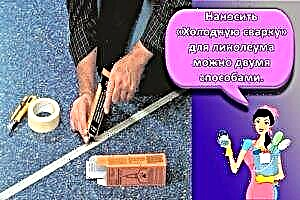
When the cut is close to the wall, it can be eliminated by dragging a small area of the canvas. Thus, the hole remains in the baguette groove and is visually invisible. To pull the matter, you will need to use high-quality glue and a piece of antenna cable. To eliminate the cut, a cable with a length of not more than 10 cm is glued parallel to the baguette to the edge of the damage. When the glue hardens, the coating at the place of work is treated with a hairdryer. Then the cable is pulled up and hidden in a baguette groove. If wrinkles have formed in other places of the stretch ceiling, they will be removed according to the same instructions.
A cut that is far from the wall is removed with a patch. To do this, use one of the previously described methods, selecting a suitable patch and fixing it on the damaged area.

How to seal a hole at home
The best way to restore a suspended ceiling in a domestic environment is to use a patch. This option is optimal when the gap is not even, but slightly rounded or diverges in different directions. Application of glue to the patch is allowed only on condition that the shape of the coating is maintained after a defect occurs. When sticking the patch on the hole in the material, you need to be extremely careful so that the restored area does not stand out against the general background.
Methods for decorating a large defect
The appearance of large defects on the stretch ceiling complicates the task of restoration and repair of damage. A regular patch will not help restore the integrity of the matter, so you need to use non-standard methods of decorating the damaged area.
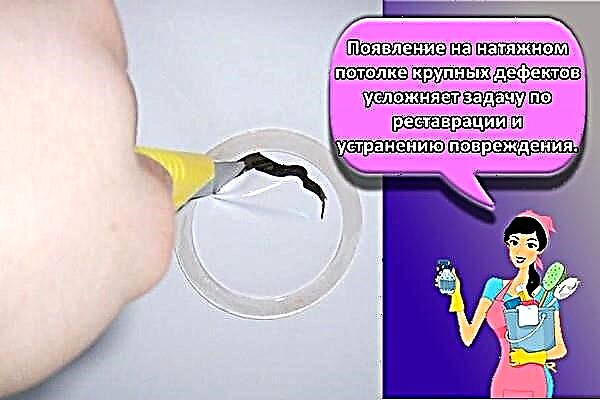
Applications
Using appliqués helps not only visually hide the cut on matter, but also decorate the space. A large number of different applications made in the form of butterflies, flowers and patterns are offered to customers to choose from. For the production of decorative applications, different materials are used, but the most popular are plastic and vinyl products. They are non-toxic, attractive in appearance, easily glued and removed.
It is important to understand that the application will hide the defect, but first you need to eliminate it. For this purpose, an adhesive solution and a clerical stapler are suitable. The edges of the slot are connected with paper clips and smeared with glue to enhance strength. The selected application is applied on top, fixed on glue for plastic.
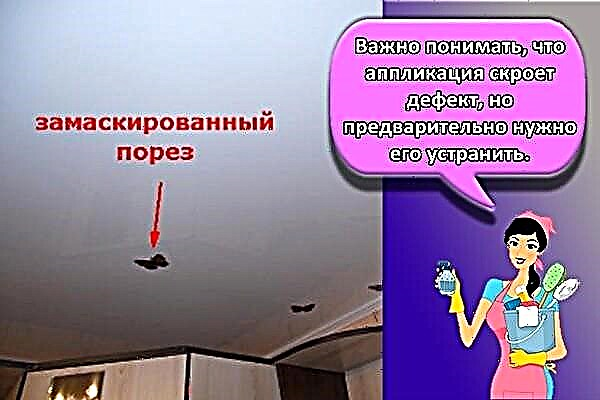
Fixture
In place of damaged matter, you can place a spotlight, which will not only hide the defect, but also improve the lighting in the room. To install the lamp step by step perform the following steps:
- A rounded profile is applied to the canvas at the site of damage and marking is made. Then the slot is leveled on the drawn circle and the profile is finally set.
- Racks are leveled so that they coincide in level with the canvas. The electrical wiring is brought out through the slotted hole and the lamp is fixed to it, after having previously put on the thermowell on its body to prevent contact of the lighting device and the tension coating.
- After installation, the lamp is leveled, a lamp is screwed into it and the performance is checked.

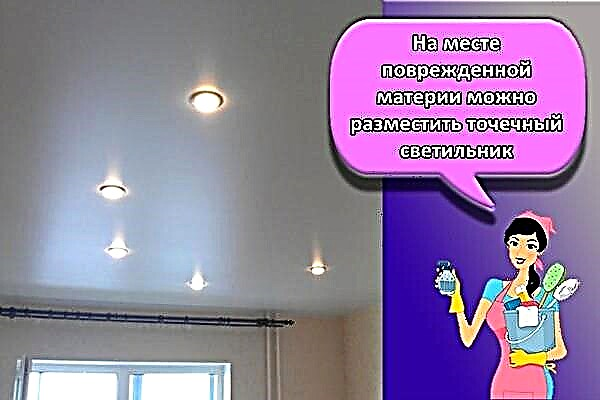
In which cases it is impossible to glue the coating
There are a number of situations where even experienced craftsmen do not need to try to fix the damage on the tension coating.These situations include:
- Tearing the web along the seam. Bonding the damaged area will only exacerbate the problem, so the material must be pulled from scratch.
- Separation of the coating from the wall. In these circumstances, it becomes necessary to dismantle the ceiling, strengthen the profile / baguette, or install a new one.
The described situations often arise due to poor installation or the use of defective material.
The only right decision would be to contact the company that was involved in the installation to replace the cover or return the funds.
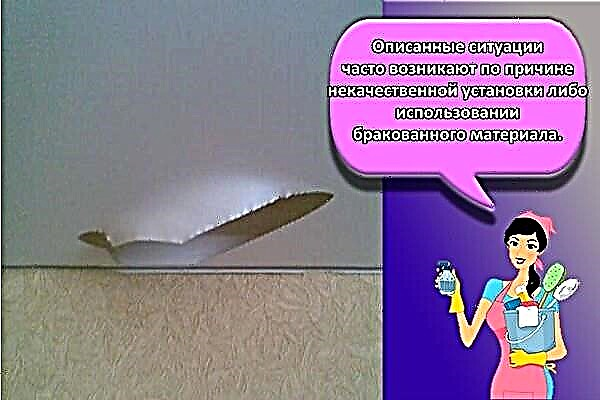
Tips for Avoiding Damage
Reducing the risk of damage to the stretch ceiling is primarily possible due to careful handling. During construction and repair work, furniture transfer, window installation, do not touch the ceiling with bulky and sharp objects. For safety reasons, a protective structure can be installed above the ceiling.
How to choose glue for stretch ceilings? Features of choice
For the production of tension structures, often used PVC film or fabric. These materials are easily damaged by aggressive substances. Chemicals can corrode the surface, which will only worsen the situation.
Many people wonder: what glue to glue a stretch ceiling? After all, some compounds are simply not suitable for such structures. Wrongly chosen glue, at best, will be ineffective, and in the worst it will “corrode” the ceiling surface. How to make the right choice? The following rules must be considered:
- Give preference to transparent formulations. If you use colored glue, ugly stains or traces may remain, as a result, the ceiling will not look aesthetically pleasing.
- An important quality is the adhesion of the glue. The quicker the grasp, the better. If the glue dries for a long time, the master will need to hold a harpoon or patch with his hand for a long time, which is not very convenient.
- In no case should you use glue for shoes.
- The most important factor is the safety of the fabric for the tension web. Some types of glue have a negative effect on the film, dissolving it. If this happens, you will have to replace the blade, without the possibility of repair.
What types of glue to use for repair?
It is allowed to use such compositions for the restoration of stretch webs:
- Universal. Suitable for all materials. Resins are present in the composition, thanks to which the glue “seizes” faster and dries better.
- Highly specialized formulations. These formulations are for specific materials. Tools can be light (suitable for gluing paper). Medium formulations can be used to work with acrylic and fabric fabrics. Heavy substances are used if you are working with vinyl or non-woven coatings.
Cosmofen
The COSMOFEN line is represented by a wide range, so you can choose a composition to fix any problem. The most popular product from the line is COSMOFEN CA12. It is suitable for both polyvinyl chloride and fabric coatings.
The composition includes a substance such as cinacrylate, which in large quantities is very dangerous to health. For this reason, the substance cannot be called completely safe. Keep the product out of the reach of children.
Nevertheless, do not be afraid to buy this glue for work. It dries very quickly, so it does not have time to do harm. Of course, you should be careful not to allow contact with the organs of vision and breathing.
COSMOFEN CA12 has the following advantages:
- Resistance to ultraviolet rays and high temperature.
- Strength.
- Quick drying.
- Suitable for the following materials: rubber, fabric, metal, leather, glass.
The direct purpose of COSMOFEN CA12 is to work with PVC surfaces. The composition was made specifically for the installation of plastic windows.
To apply such glue for stretch ceilings is very careful, continuous thin line. The container in which the product is sold has a small nose. It provides ease of application.
Cosmoplast
In composition and properties similar to the COSMOFEN series. COSMOPLAST 500, 500L, 513 are used to restore stretch linens. The choice depends on what goal you are pursuing, since the compositions differ in setting time. COSMOPLAST 513 forms an elastic film on the surface, while the 500 and 500L are highly durable. . The COSMOPLAST 500 dries in 3 seconds, and the COSMOPLAST 500L takes about 5 seconds to dry completely. COSMOPLAST 513 freezes for the longest time - 15 seconds.
How to remove glue residue from the tension coating?
Polyvinyl chloride film - a material characterized by a brittle structure. When caring for such a coating, do not use mops or brushes with hard bristles. The canvas is very taut, so it can not withstand pressure. Remains of glue should be removed very carefully. For work, a soft sponge and a glue cleaner, which is sold in any hardware store, are suitable.
Please note that glue for stretch coatings is more difficult to remove from the surface, so more effort will be required.
We remove super-glue from a stretch ceiling
Use of a wash or cleaning agent
To remove fresh glue, a special wash is used, the stain is abundantly moistened with it, and then wiped. If the first time it was not possible to completely remove the residues, you can repeat the manipulation several more times.
To clean the surface of glue that has already dried, it will take more time and effort. An adhesive cleaner will be required, it is applied and left for a day, and then removed with a sponge. You should be aware that the substances used for stretch coatings should not contain chlorine or any aggressive substances. They adversely affect the film, can ruin the appearance of the structure.
How to restore the tension coating?
To correctly answer the question: "How to glue a stretch ceiling?"- you need to deal with many nuances. Also, you should know the technology of ceiling restoration.
First of all, find a piece of fabric among the materials left after work. Such a patch will become a patch when repairing the tension coating. In size, the patch should be slightly larger than the damaged area. If there is nothing among the residues, you will need to look for an alternative. Suppose you can find a similar material and make a patch from it.
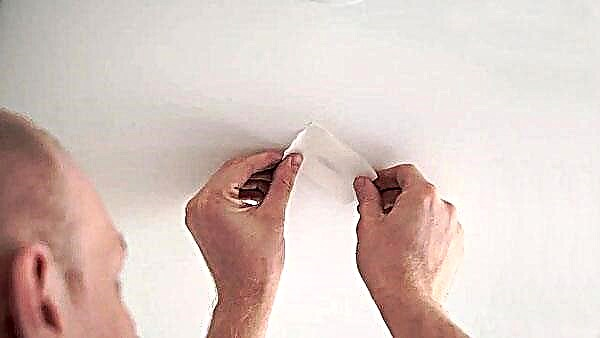
Then glue is applied to the patch, but not too much, otherwise it will spread over the surface, leaving ugly marks. Then a piece of tissue is brought to the damaged area and pressed strongly against it. Do not press hard, otherwise wrinkles will appear. When the patch "grasps" well, you need to gently smooth it.
When is it impossible to repair a damaged sheet?
To the question,is it possible to glue a stretch ceiling, cannot be answered unequivocally. In certain situations, the PVC fabric cannot be restored. The only option is a complete replacement of the canvas. Such problematic cases include damage that occurs at the joints. It can be concluded that the restoration of a stretch ceiling is not an easy task. In some cases, you have to make a lot of efforts to make a quality repair. The right choice of glue is one of the most important nuances when working. You should choose only those compounds that are suitable for the method of application. Also, you must strictly follow the instructions that are on each package. Following these recommendations, it is quite possible to make a quality repair.
Glue selection rules
Stretch ceilings are made of PVC film and polyester fabric. These artificial materials can easily be damaged if a chemically active substance is applied to their surface. It can simply corrode the surface and increase the scale of the "disaster." Some types of adhesive compositions are simply not able to grasp the surface of the stretch ceiling, so their use will be completely useless.
Note!
To order glue for the repair of suspended ceilings at a bargain price from the manufacturer, follow the link. Sending orders to all cities of the country.
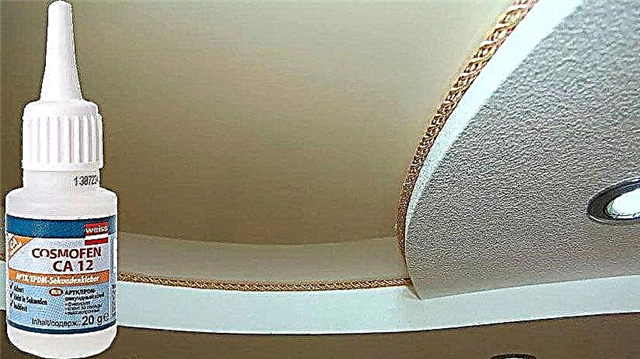
Fig. 1. Cosmofen - the best adhesive for stretch ceilings
Let's figure out what kind of glue you can glue the stretch ceiling. To choose the right adhesive, it is important to be guided by the following rules.
- Better use clear glue.. Using glue in white or any other color can lead to the formation of stains on the surface of the stretch ceiling, which will be very difficult to eliminate.
- The glue must set instantly. This will save you from having to hold a patch or harpoon for hours.
- The adhesive must be safe for the canvas. Many types of glue can simply dissolve the surface of the stretch ceiling. As a result, you have to change the coverage.
In order not to risk the integrity of the stretch ceiling, only specially designed types of glue should be used for repairs. No glue for shoes and, especially, “Superglue” is highly recommended.
Cosmofen - the best adhesive for stretch ceilings
A fairly wide selection of adhesives for repairing stretch ceilings is offered on the modern market. However, not all of them are equally effective. What glue can be used to glue the stretch ceiling so as not to damage it and ensure the strength of the coating for many years? Specialists involved in the installation and repair of tension structures, recommend the use of glue called Cosmofen (Cosmofen). These products are represented by a wide range with different compositions that are suitable for certain tasks. 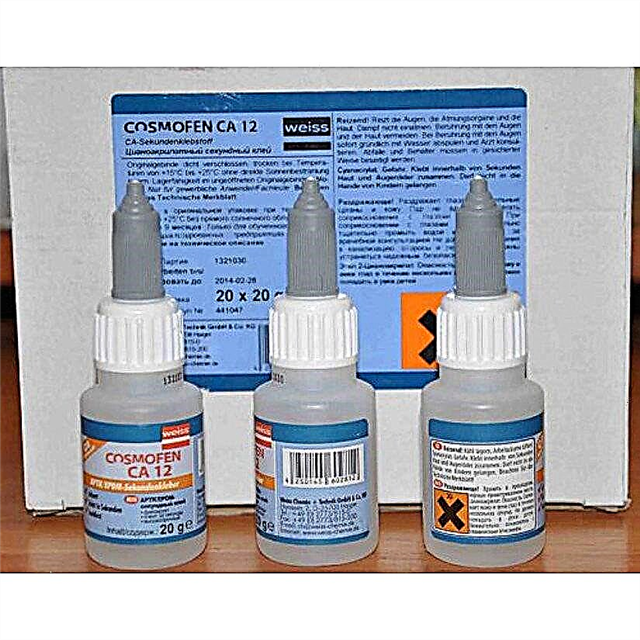
Fig. 2. Experts recommend using an adhesive called Cosmofen
For repair of stretch ceilings it is best to use Cosmofen CA 12 adhesive. It seizes in a few seconds and guarantees a firm connection to the surface. Importantly, this glue is colorless and therefore leaves no visible marks on the surface of the ceiling. It can be used not only for repair of stretch linens, but also for gluing rubber products, hard plastic, leather, artificial fabrics, window seals and other products.
Cosmofen is applied directly to the surface of a stretch ceiling. Before performing repairs, it is recommended to clean it from contamination. The glue is one-component, therefore, does not require the addition of additional compounds. It provides a strong connection that persists even when exposed to high temperatures and direct sunlight.
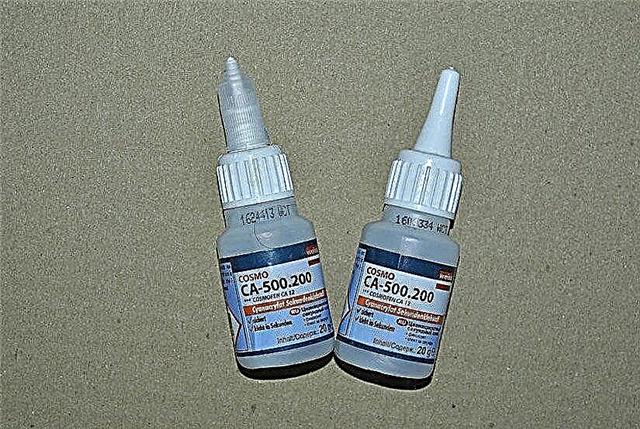
Fig. 3. Cosmofen CA 12– adhesive for solid surface
An original way to repair a stretch ceiling
Now you know what glue you can glue the stretch ceiling. You can buy it at a bargain price in the online store of the Asta M company.
However, this is not the only way to repair such a coating. Today there are special vinyl stickers. They are issued in the form of various drawings. For example, you can close a hole on a stretch ceiling with a sticker with a colorful butterfly, flower, asterisk, geometric shape or any other element. The use of self-adhesive patterns will not only allow you to repair, but also decorate your stretch ceiling.


